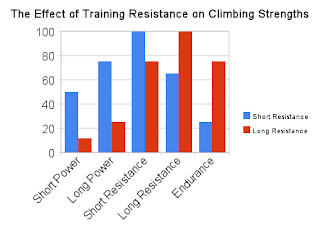There was some confusion about the chart from the last post. I'll split it up into several charts here and discuss.
So as seen above training short power(1-4 move boulder problems) has a little carryover into resistance and decreases endurance. Long power(4-12 move boulder problems) is widely helpful.
Short resistance(12-30 moves) has good carryover into all climbing strengths, while long resistance(30-60 moves) does little to help power of any kind.
As seen above training endurance is a real killer. There are cases that could be made for training endurance as active recovery, or for building one's "base" fitness.
Discussion
The charts above come from my personal experience with training each of the facets of climbing. The interplay of climbing strengths is probably fairly unique for each individual. Depending on the time of the year or my projects I will train different mixes of power, resistance, and endurance. This can be broken into a 5-tuple with the sum of the entries 100. So (20, 20, 20, 20, 20) would mean an even split between training short power, long power, short resistance, long resistance and endurance(20% of training time for each). Now that we have notation, I'll list a few scenarios below.
Bouldering: For bouldering around the northeast, where problems tend to be short I find training (60,30,10,0,0) to be useful. For bouldering elsewhere and as a general prep for sport climbing I find (40,40,20,0,0) to be a good mix.
Sport Climbing: For climbing at Rumney (33,33,33,0,0) seems good. Any other sport climbing location needs a shift toward the endurance end: (10,20,30,30,10) for onsite climbing, and (10,20,40,30,0) for redpointing.



I felt dizzy after trying to decipher this.
ReplyDelete